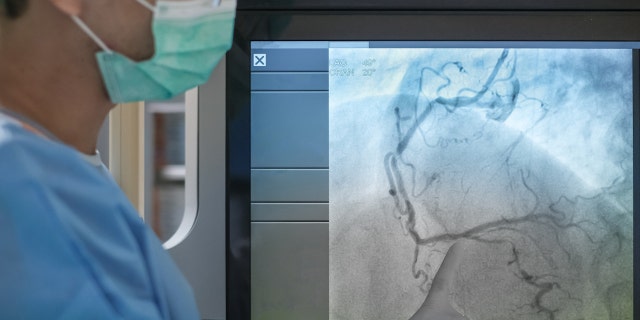
Heart disease is known as the “silent killer” for a reason — an estimated 45% of all heart attacks come without any of the classic symptoms, according to Harvard Medical School.
Now, a new study published in the Annals of Internal Medicine has found that nearly half of the participants were found to have signs of coronary heart disease or atherosclerosis — a plaque build-up in the arteries that can restrict blood flow — despite having no prior symptoms.
Researchers from Copenhagen University Hospital in Denmark studied over 9,000 people age 40 or older who had no symptoms and no history of heart disease.
KETO DIETS COULD INCREASE RISK OF HEART ATTACK AND STROKE, SAYS NEW STUDY
Doctors used angiograms, which are medical images that show the inside of the heart, to determine the results.
A little more than half of the participants had no sign of heart disease. However, 36% had “nonobstructive disease,” which means there was some plaque buildup in the arteries but not enough to cause a blockage. Another 10% had “obstructive disease,” which involves significant plaque buildup that could narrow or block the arteries.

An estimated 45% of all heart attacks come without any of the classic symptoms. (iStock)
Those who showed obstructive and extensive disease were at the highest risk for future heart attacks, the findings stated.
Within about 3.5 years, 193 people involved with the study had died and 71 had experienced heart attacks.
Fox News Digital reached out to the study authors for comment.
Dr. Adedapo Iluyomade, a preventive cardiologist at Baptist Health Miami Cardiac & Vascular Institute in South Florida, was not involved in the study but reviewed the findings.
“This study supports the importance of focusing on early prevention and early identification of patients who would be considered high-risk for future cardiovascular events,” he told Fox News Digital in an interview.
Who is at high risk?
The primary risk factors for heart disease include smoking, high blood pressure, diabetes, obesity, high low-density lipoprotein (LDL) cholesterol, unhealthy diet, a sedentary lifestyle and secondhand smoke exposure, according to the Centers for Disease Control and Prevention (CDC).
Some risk factors, such as sex and age, can’t be modified.
Nearly half the participants had some degree of heart disease, but no symptoms.
“Males are at a higher risk, as are people who are over the age of 65,” said Dr. Iluyomade. “But at the same time, studies have shown that the process of atherosclerosis begins very early on and very silently.”
The doctor warns that as early as age 10 or 11, fatty streaks can already be found in the arteries, which can develop eventually into a significant buildup of plaque in the arteries.
“There are some risk factors, such as genetics, environmental aspects and chronic inflammation, that can’t be easily plugged into a risk calculator or assessment tool,” he said.

In the study, doctors used angiograms, which are medical images that show the inside of the heart, to determine participants’ heart health. (iStock)
“Coronary atherosclerosis often develops in the absence of symptoms because the underlying risk factors, such as high blood pressure and high cholesterol, typically don’t cause symptoms either,” said Dr. Jim Liu, a cardiologist at The Ohio State University Wexner Medical Center. He was not involved in the study.
“It’s important for patients to see their health care providers routinely to make sure those risk factors are addressed.”
Doctor calls for preventive screenings
Dr. Iluyomade is hopeful that increasing the availability of heart health screenings for people without symptoms could help save lives.
In particular, he recommends rolling out calcium-score screening heart tests, which use computerized tomography (CT) to detect any plaque buildup in the arteries.
5 SIMPLE WAYS TO HELP PREVENT HEART DISEASE THIS YEAR
“CT calcium scoring can detect whether plaque in the coronary arteries is obstructing blood flow or not,” he said. “It takes just seven minutes and the radiation exposure is minimal.”
Insurance typically does not cover a CT calcium test; the cost is usually between $100 and $400, according to Healthline.
Another screening option is CT angiography, which was used in the Copenhagen University study. This test involves injecting dye into the patient using an IV and then taking images of blood vessels to detect any potential blockages.

“It’s important for patients to see their health care providers routinely to make sure risk factors are addressed,” a cardiologist told Fox News Digital. (iStock)
In most cases, insurance will only pay for CT angiography if the patient has symptoms, said Dr. Iluyomade.
CLICK HERE TO SIGN UP FOR OUR HEALTH NEWSLETTER
The main limitation of the Copenhagen study is that only White people in Denmark were included in the research.
Despite the challenges that remain, Dr. Iluyomade is encouraged by the progress that’s been made.
CLICK HERE TO GET THE FOX NEWS APP
“I think it’s a great day and age for preventive cardiology, in that we’re able to detect disease before it becomes symptomatic and prevent it from causing issues,” he said.
In 2020, about 697,000 people in the U.S. died from heart disease, per CDC data.
It’s the leading cause of death for men, women and people of most racial and ethnic groups in the country.

 Latest Breaking News Online News Portal
Latest Breaking News Online News Portal




